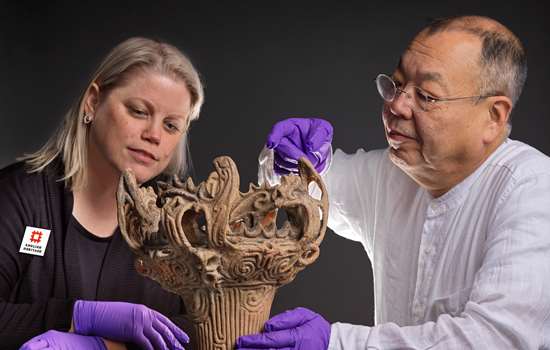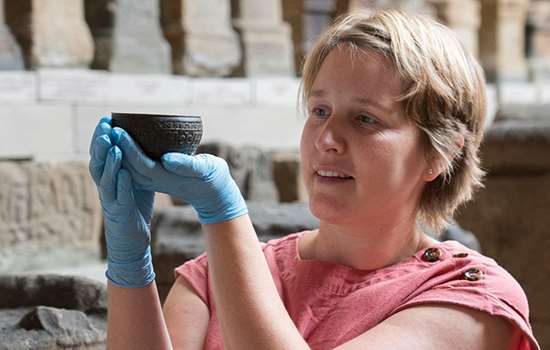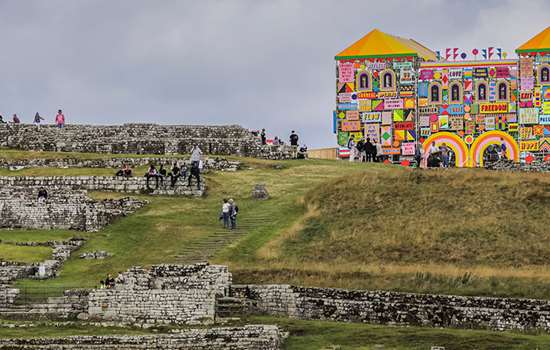12/10/2021
New research reveals Roman ‘wrestler’ figurine actually depicts African warrior
- Lead figurine had been misidentified since the 1920s
- Roman artefact on display throughout Black History Month
A lead figurine of a wrestler produced during the Roman era is now understood to be an African warrior, new research by English Heritage has revealed. The figurine, discovered a century ago at Wall Roman Site in Staffordshire, was first thought to depict an enslaved person, and later a wrestler, but the charity has now discovered evidence that the figurine originally carried a spear in one hand, finally revealing its true identity as an African warrior. The figurine is on display at Wall Roman Site’s museum until the end of October when the museum will close for the winter.
Discovered in the 1920s in a Roman cemetery at Wall Roman Site – an important staging post on Watling Street, the Roman military road to north Wales – the figurine, which dates from the 1st century AD, is just 55mm high and made of lead. It wears an armlet on each upper arm and a necklace of large beads. It is likely that the figurine was included as a grave good in an interred cremation burial. Originally thought to be a representation of an enslaved person with a facial expression interpreted as one of suffering, this analysis was reassessed in the 1990s and reinterpreted as a wrestler as the figure appeared to be sitting on the ground with its legs folded, as a wrestler might (although we now know that the object’s soft metal was at some point distorted by heat affecting its lower half). However, new research from English Heritage Curator Cameron Moffett has revealed a previously unobserved socket in the figurine’s right hand which would have held a weapon, likely a bronze spear, and that the figure would have stood upright. The image of an African man shown with a spear is common in art in the Classical period and is often called the African Warrior, and this fascinating new discovery means that the true identity of the figurine can finally be revealed.
Cameron Moffett, English Heritage Curator, said:
'These fragments of past lives are vital to our understanding of the people who lived thousands of years ago, but it is also interesting how interpretations can change over time. In the 1920s this figurine was thought to depict an enslaved person, and then a wrestler, but we now know that both of those assertions were mistaken. This object actually depicts an African warrior, standing tall and carrying a spear, and the fact that it was a grave good indicates that it would have been a significant possession to its owner.'
'During the Roman invasion of Britain, huge numbers of people travelled here from many different parts of the Empire, and while we can only guess at the identity of the object’s carrier, I think it’s very possible that its owner may have seen something of themselves in this object, so important was it to them that they chose to be united with it in death.'
Grave goods, such as this figurine, were significant possessions and essential supplies included in a burial to help the deceased pass over into the realm of the dead. Any bones that survived the cremation process would have been put in ceramic vessels which were then placed in the bottom of an open grave, accompanied by grave goods. The ashes from the funeral pyre were then poured over and around the grave’s contents. Inclusion in such a burial may account for the partial melting of just the lower half of the figurine.
As to how the figurine came to be discovered at Wall Roman Site, it is very unlikely that this piece was made in Britain, though once they had been introduced, metal figurines were made here. This particular figurine is sufficiently unusual to indicate that it was made on the Continent, possibly close to the Mediterranean. While we do not have a clear provenance for the figurine, the evidence that it was used as a grave good suggests one possible history – that an individual acquired this unusual piece of art on the Continent, travelled thousands of miles with it, and was buried with it in a foreign land.
For more information about Wall Roman Site and how to visit: www.english-heritage.org.uk/visit/places/wall-roman-site/
For more information about the African Warrior figurine visit: www.english-heritage.org.uk/lead-figurine
For more from English Heritage, follow us on Twitter, Facebook and Instagram.




